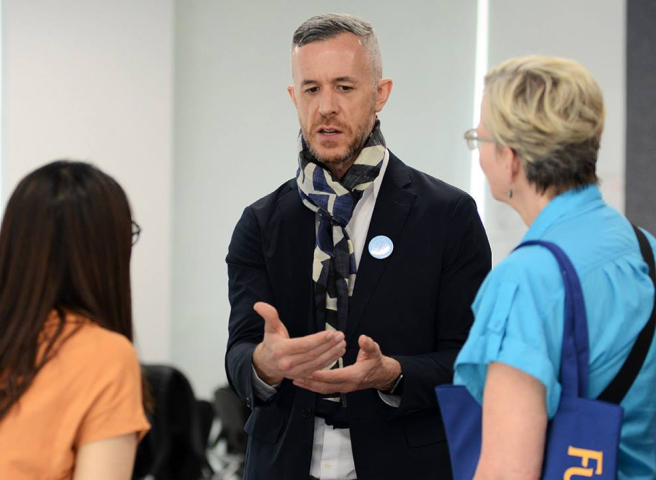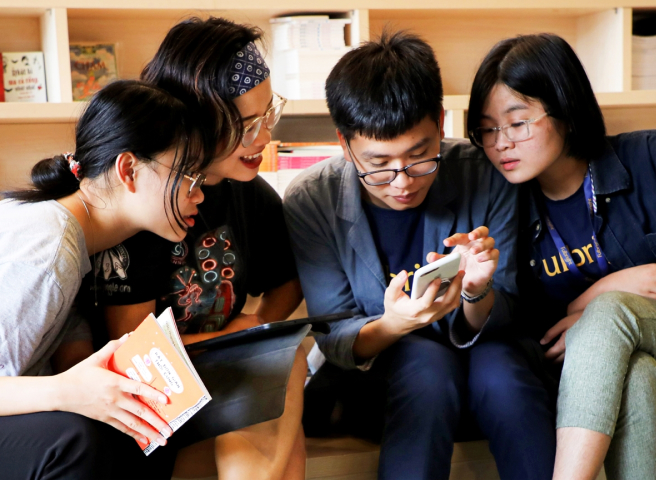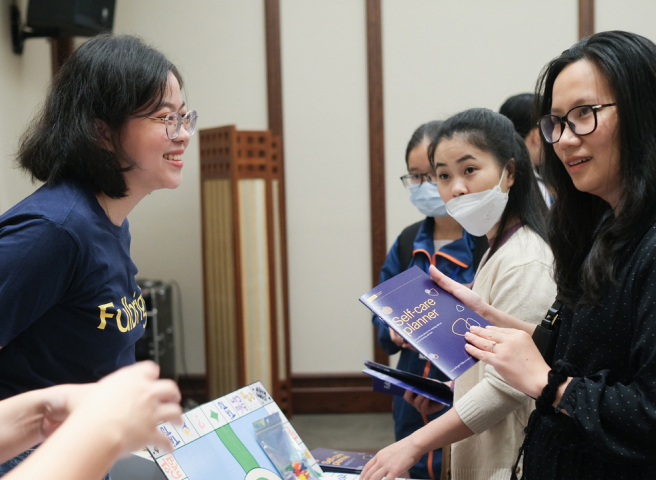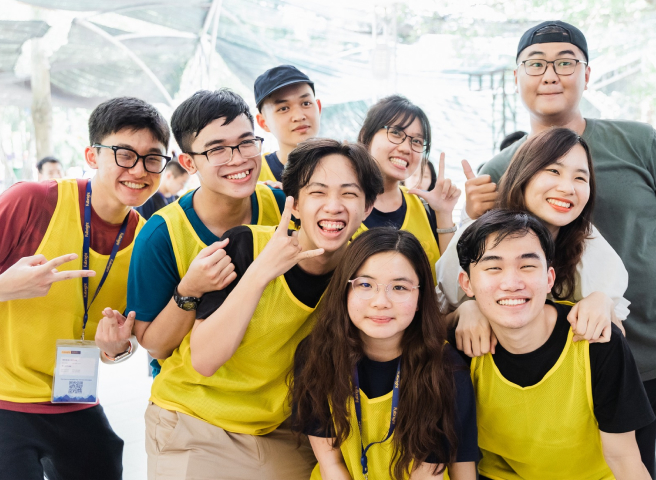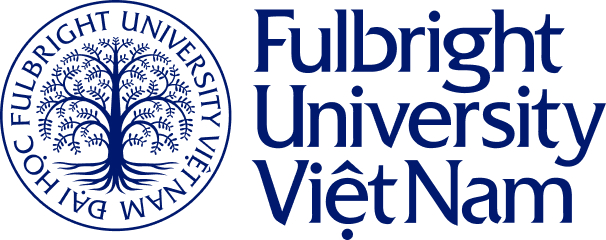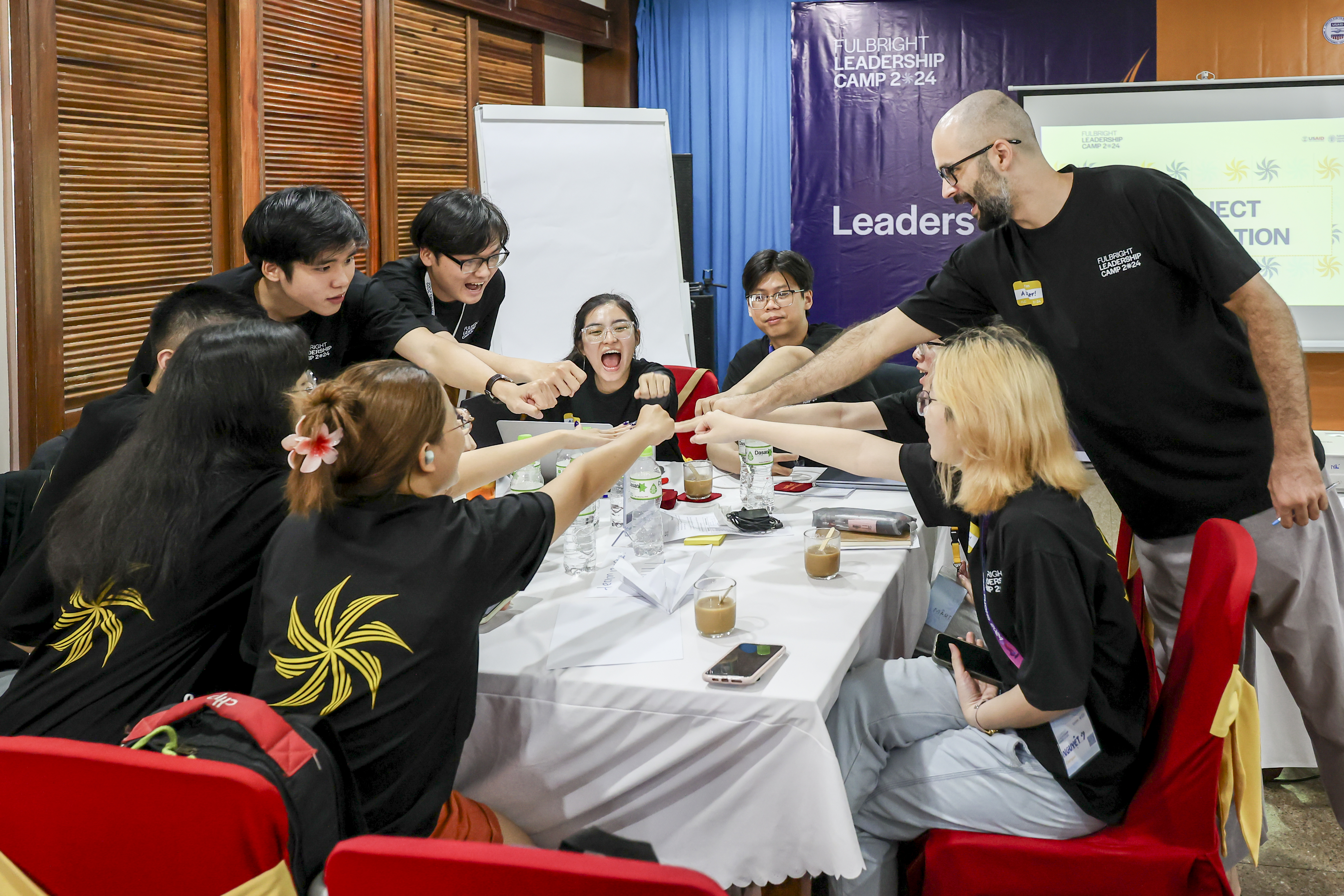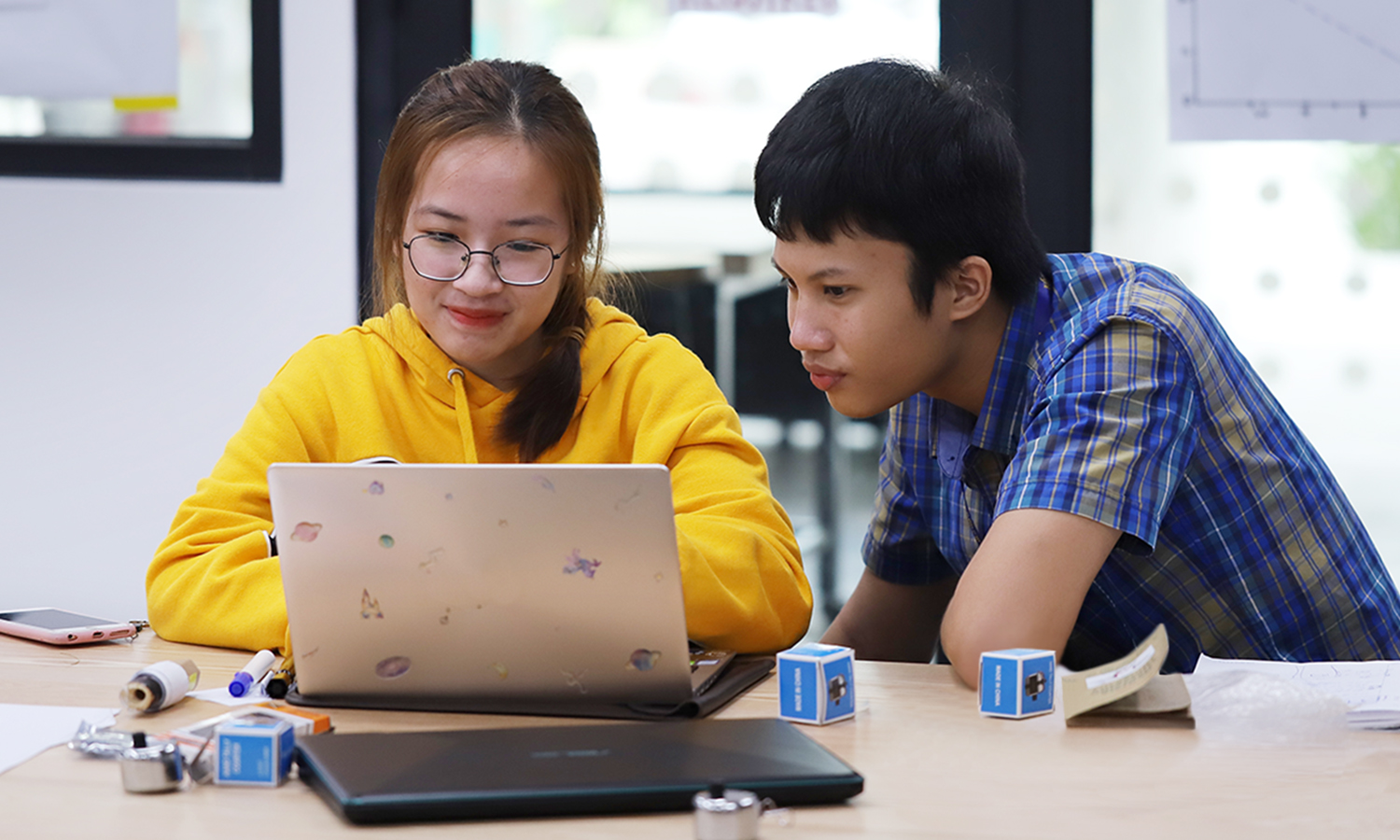
Tại Fulbright, sinh viên bắt đầu hành trình học tập và trải nghiệm của mình bằng việc xây dựng hệ thống kiến thức phổ quát cũng như các bộ kỹ năng cơ bản, thông qua các môn học Nền tảng bắt buộc. Chương trình đào tạo nền tảng là đặc điểm chung của các trường theo mô hình giáo dục khai phóng Hoa Kỳ, tuy nhiên ở đây, chương trình được thiết kế và tinh chỉnh để đáp ứng tốt nhất với các xu hướng và thách thức giáo dục toàn cầu, đồng thời bắt rễ sâu sắc vào bối cảnh Việt Nam
Phát triển các bộ kỹ năng thực tiễn
So với những thế hệ đi trước, sinh viên ngày nay đặt nặng vấn đề chuẩn bị cho sự nghiệp sau này. Ông Arthur Levine, nguyên hiệu trưởng trường Đại học Sư phạm, Đại học Columbia cho hay, “Sinh viên đã trở nên thực dụng hơn nhiều. Các em bày tỏ, lý do chính thôi thúc việc học đại học là để có được các kỹ năng giúp tìm kiếm việc làm và có được thu nhập.” Đây là một trong những tâm lý chi phối nền giáo dục thế kỷ 21. Một khảo sát do Hiệp hội các trường Đại học và Cao đẳng Hoa Kỳ (AACU) ủy nhiệm cho thấy, trong nền kinh tế có tốc độ phát triển nhanh và cạnh tranh mạnh mẽ như hiện nay, những công việc mang lại thu nhập cao đòi hỏi cả kiến thức chuyên sâu về một lĩnh vực nhất định cũng như các kỹ năng liên ngành đa dạng. Trong đó, có nhiều kỹ năng được phát triển vượt trội trong môi trường giáo dục khai phóng.
Các ngành nghệ thuật, khoa học xã hội và nhân văn vốn được coi là cốt lõi của giáo dục khai phóng. Tuy nhiên, các trường đại học hiện đại thường hướng tới những chương trình đào tạo toàn diện hơn, với trọng tâm mới xoay quanh các môn học STEM (khoa học, công nghệ, kỹ thuật và toán học). Tại Fulbright, chương trình Đào tạo Nền tảng bao gồm năm môn học trải rộng trên nhiều lĩnh vực, giúp sinh viên hình thành một thế giới quan đa chiều và chuẩn bị cho quá trình học tập, làm việc lâu dài. Các môn học Nền tảng tại Fulbright bao gồm: Khám phá Khoa học; Lý luận Định lượng cho Thời đại Số; Tư duy Thiết kế và Hệ thống; Lịch sử Triết học và Thay đổi Xã hội; và Văn hóa và Xã hội Việt Nam Hiện đại.
Với Chương trình Đào tạo Nền tảng, điểm đặc biệt không chỉ nằm ở nội dung giảng dạy. Mục tiêu chính của những môn học này là phát triển các kỹ năng và tư duy học thuật thiết yếu cho sinh viên. Điển hình như môn Lý luận Định lượng cho Thời đại Số cung cấp cho sinh viên các công cụ toán học và tin học cơ bản để giải quyết vấn đề trong cuộc sống, nhưng không nhất thiết nhằm đào tạo các nhà toán học hay nhà khoa học dữ liệu tương lai. Thay vào đó, sinh viên học cách suy nghĩ logic, quan sát các hiện tượng qua lăng kính của những con số, xóa bỏ những thành kiến chủ quan cá nhân và làm việc theo nhóm. Những kỹ năng này cho phép sinh viên đưa ra những đánh giá, nhận định chính xác hơn dựa trên bằng chứng cụ thể và giao tiếp hiệu quả hơn ở nơi làm việc.
Tương tự, môn Khám phá Khoa học dẫn dắt sinh viên vào thế giới của các ngành khoa học tự nhiên. “Đây không phải môn học về vật lý, sinh học, hóa học hay bất cứ lĩnh vực nào cụ thể, nó tập trung vào khía cạnh kỹ năng nhiều hơn khía cạnh nội dung. Chúng tôi muốn sinh viên đặt mình vào vị trí của một nhà khoa học, suy nghĩ như một nhà khoa học, hiểu ý nghĩa của dữ liệu khoa học và biết được kiến thức khoa học được tạo ra như thế nào,” Tiến sĩ Samhitha Raj, một trong bốn giảng viên phụ trách bộ môn cho biết. Thông qua các dự án nhóm, sinh viên được thực hành thu thập, phân tích và diễn giải dữ liệu, cũng như đánh giá một cách phản biện các tuyên bố khoa học.
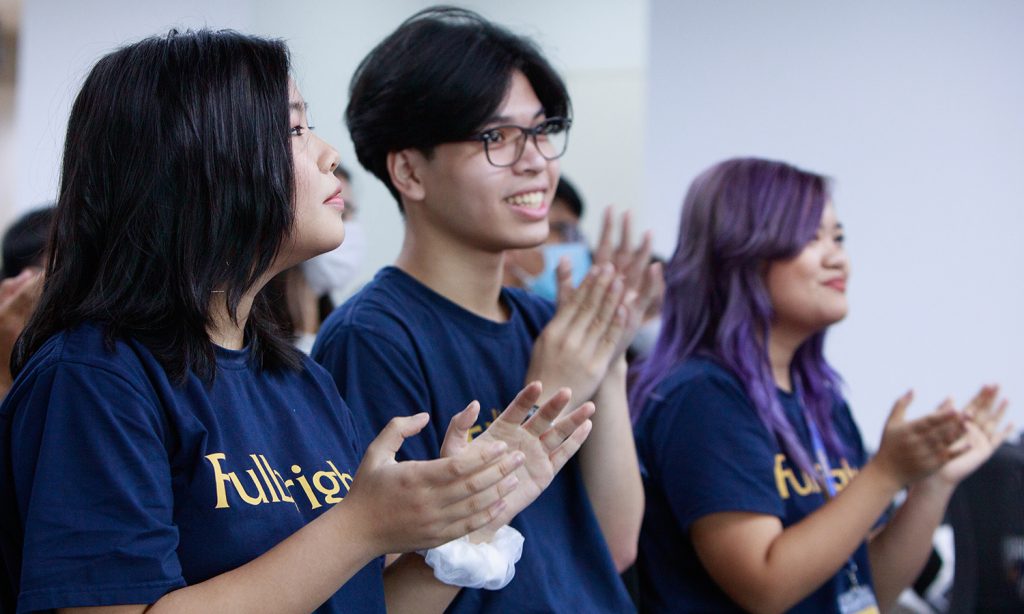
Những công dân tích cực, hiểu biết và giàu trách nhiệm
Bên cạnh những kỹ năng có tính thực tiễn cao, sinh viên còn được trang bị kiến thức để trở thành những con người nhân văn, hiểu biết về thế giới và có khả năng thấu cảm với những người xung quanh. Trong một lớp học với những người bạn khác biệt cả về gia cảnh, sở trường và mối quan tâm, sinh viên học cách thảo luận những ý kiến đa chiều trên tinh thần tôn trọng lẫn nhau.
Với môn Lịch sử Triết học và Thay đổi Xã hội, sinh viên được học về những thời khắc then chốt trong lịch sử tư tưởng nhân loại và tiếp xúc với kho tàng các văn bản văn học, triết học, tôn giáo và nghệ thuật cổ điển, từ sự phát triển của các tư tưởng nổi bật xuyên suốt chiều dài lịch sử cho đến cách những ý tưởng đó gây ra biến đổi xã hội và định hình nhận thức trong thế giới đương đại. Ngoài ra, môn học còn tạo cơ hội cho sinh viên phê bình quan điểm của nhau trong các cuộc thảo luận nhóm, từ đó giúp các bạn hình thành những góc nhìn cân bằng và bao dung hơn.
Trong khi đó, môn Tư duy Thiết kế và Hệ thống giúp sinh viên xác định và giải quyết những mâu thuẫn trong xã hội. Qua môn học này, các bạn được làm quen với một loạt các công cụ, nguyên tắc và quy trình kỹ thuật, chẳng hạn như cách xác định và giải thích sự cạnh tranh trên thị trường cùng các cơ hội liên quan; các bước thiết kế và chế tạo sản phẩm phục vụ một mục đích nhất định cho xã hội; hay làm thế nào để đưa ra những lựa chọn và giải pháp tối ưu, dựa trên những đánh giá về kỹ thuật.
Một vấn đề mà những sinh viên theo học các chương trình quốc tế thường gặp phải là cảm giác lạc lõng trên chính đất nước của mình và khó khăn trong việc áp dụng những gì đã học vào bối cảnh Việt Nam. Môn học Văn hóa và Xã hội Việt Nam Hiện đại chính là lời giải cho vấn đề này. Bằng việc đi sâu phân tích các vấn đề mà Việt Nam đang phải đối mặt, từ các khía cạnh lịch sử, văn hóa, xã hội, kinh tế và cả chính trị, khóa học này giúp người học hiểu rõ về bản sắc Việt Nam và từ đó nhìn nhận đúng đắn về vị thế Việt Nam trong khu vực và trên thế giới. Dựa trên tư duy cởi mở và phản biện, đây là động lực để các bạn có những đóng góp ý nghĩa cho cộng đồng, theo những cách riêng của mình.
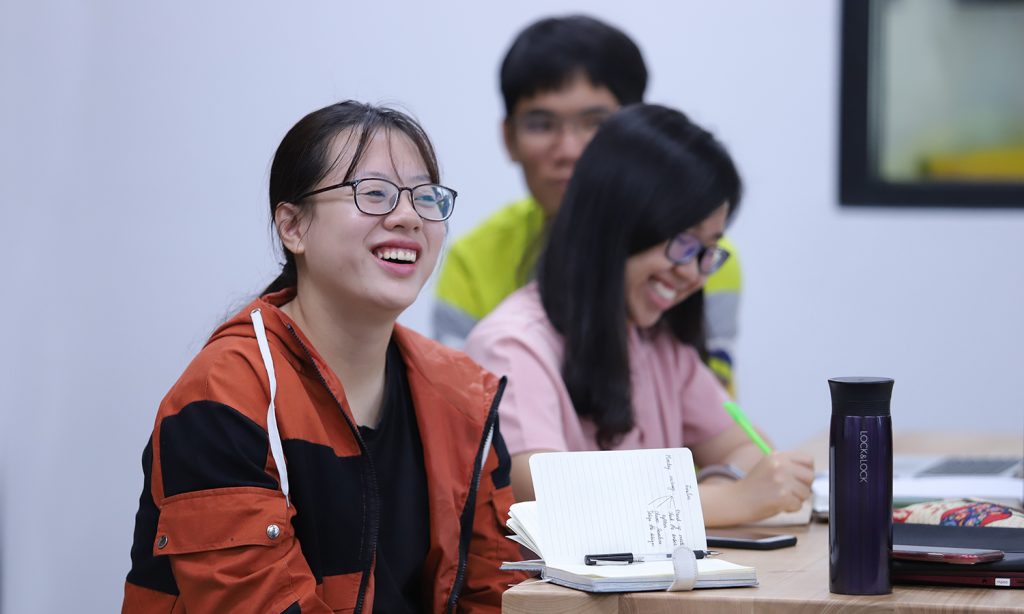
Khởi đầu cho hành trình học tập trọn đời
Vào năm 2014, tổ chức Gallup đã tiến hành khảo sát về mối tương quan giữa trải nghiệm đại học và mức độ thành công trong nghề nghiệp – cuộc sống của sinh viên sau khi ra trường. Kết quả cho thấy những con số không mấy tích cực. Chỉ có 39% sinh viên sau khi tốt nghiệp tham gia tích cực trong công việc, và chỉ 11% có được cuộc sống trọn vẹn cả về thể chất, giao tiếp xã hội, tài chính, quan hệ với cộng đồng và mục đích sống. Khảo sát này cũng cho thấy sinh viên có nhiều khả năng đạt được sự viên mãn hơn nếu trường đại học giúp họ chuẩn bị vững vàng cho cuộc sống sau khi tốt nghiệp.
Đó cũng là mục tiêu mà Fulbright nỗ lực hướng tới. Sau khi rời mái trường Fulbright, các bài học và kỹ năng từ Chương trình Đào tạo Nền tảng chắc chắn vẫn sẽ mang lại những giá trị to lớn trong suốt cuộc đời của mỗi sinh viên. Trước một tương lai đầy rẫy những thay đổi khó lường, người ta chỉ có thể thành công nếu họ hiểu về lịch sử và những gì đã hình thành nên thế giới ngày nay. Và khi thế giới càng phát triển, những kiến thức mới sẽ xuất hiện, sinh viên tốt nghiệp sẽ tụt lại phía sau nếu không có tư duy logic và phản biện, khả năng giải quyết vấn đề hiệu quả, kỹ năng giao tiếp và một trí óc tò mò không ngừng học hỏi.
Mặc dù sinh viên dành hai năm học đầu tiên để trải nghiệm nhiều lĩnh vực khác nhau trước khi lựa chọn chuyên ngành nhưng rất có thể sau này, các bạn sẽ muốn hoặc cần phải thay đổi nghề nghiệp. Trên thực tế, một nghiên cứu từ Ngân hàng Dự trữ Liên bang New York cho thấy chỉ có 27% sinh viên tốt nghiệp đại học làm việc trong lĩnh vực liên quan đến chuyên ngành của họ. Với dữ liệu từ 125 triệu hồ sơ nghề nghiệp, Emsi, một công ty phân tích thị trường lao động cũng đưa ra kết luận rằng “con đường điển hình giống một vòng xoáy hơn là một đường thẳng”.
Trong trường hợp sinh viên quyết định thay đổi nghề nghiệp, những kiến thức nền tảng sẽ vô cùng hữu ích trong quá trình chuyển đổi, giúp các bạn thích nghi nhanh hơn với môi trường mới. Từ một nền móng vững chắc, sinh viên sẽ dễ dàng bồi đắp thêm các kỹ năng và kiến thức mới, không ngừng học hỏi và cải thiện bản thân. Nhưng quan trọng hơn cả, các bạn sẽ đối mặt thử thách với một thái độ tự tin và can đảm. Tiến sĩ Trần Vĩnh Linh, một trong ba giảng viên môn Lý luận Định lượng khẳng định, “Các em sẽ dũng cảm, sẵn sàng thử sức với những điều mới mẻ.”
Anh Thư
